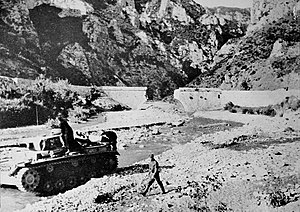Battle of Thermopylae (1941)
| Battle of Thermopylae (1941) | |||||||
|---|---|---|---|---|---|---|---|
| Part of the German invasion of Greece | |||||||
 German forces in Thermopylae following the battle |
|||||||
|
|||||||
| Belligerents | |||||||
|
|
|
||||||
| Commanders and leaders | |||||||
|
|
|
||||||
| Casualties and losses | |||||||
| ~100 casualties 15 tanks destroyed |
|||||||
German victory
The Battle of Thermopylae, on 24–25 April 1941, was part of the German invasion of Greece during World War II.
Following the retreat of Allied forces from the mountain passes at Olympus and Servia. British Commonwealth forces began to set up defensive position at the coastal pass at Thermopylae, famous for the Battle of Thermopylae in 480BC. The New Zealand Army's 2nd Infantry Division under Lieutenant-General Bernard Freyberg was given the task of defending the pass, while elements of the Australian 6th Infantry Division, under Major General Iven Mackay, defended the village of Brallos.
In the New Zealand sector, the 5th Brigade was deployed along the coastal road, the foothills south of Lamia, and the Spercheios River, with the 4th Brigade was on the right flank, where it had established coast-watching patrols. The 6th Brigade was in reserve. The Australian force defending Brallos was comprised predominantly of two battalions from the 19th Brigade, under Brigadier George Vasey: the 2/4th and 2/8th battalions. On 19 April they were augmented by the 2/1st and 2/5th battalions (from the 16th and 17th Brigades respectively), which were also put under Vasey's command. Later that day and during the early hours of 20 April, the 2/11th Battalion, the third battalion comprising the 19th Brigade, also arrived at Brallos.
...
Wikipedia
